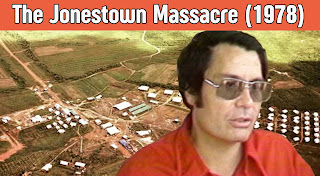
Jonestown Massacre (1978)
[MK-Ultra: "James Jones" = 666 (Sumerian)]
The Peoples Temple Agricultural Project, better known by its informal name "Jonestown", was a remote settlement established by the Peoples Temple, a San Francisco-based cult under the leadership of Jim Jones, in Guyana.
The settlement became internationally known when, on November 18, 1978, a total of 918 people died at the settlement, at the nearby airstrip in Port Kaituma, and at a Temple-run building in Georgetown, Guyana's capital city. The name of the settlement became synonymous with the incidents at those locations.
In total, 909 individuals died in Jonestown, all but two from apparent cyanide poisoning, in an event termed "revolutionary suicide" by Jones and some Peoples Temple members on an audio tape of the event, and in prior recorded discussions. The poisonings in Jonestown followed the murder of five others by Temple members at Port Kaituma, including United States Congressman Leo Ryan, an act that Jones ordered. Four other Temple members committed murder–suicide in Georgetown at Jones' command.
Terms used to describe the deaths in Jonestown and Georgetown evolved over time. Many contemporary media accounts after the events called the deaths a mass suicide. In contrast, most sources today refer to the deaths with terms such as mass murder–suicide, a massacre, or simply mass murder. Seventy or more individuals at Jonestown were injected with poison, and a third of the victims (304) were minors. Guards armed with guns and crossbows had been ordered to shoot those who fled the Jonestown pavilion as Jones lobbied for suicide.
Jonestown resulted in the largest single loss of American civilian life in a deliberate act until September 11, 2001.
"Jonestown massacre memories linger amid rumors of CIA link"
Copyright Disclaimer Under Section 107 of the Copyright Act 1976, allowance is made for "fair use" for purposes such as criticism, comment, news reporting, teaching, scholarship, and research. Fair use is a use permitted by copyright statute that might otherwise be infringing. Non-profit, educational or personal use tips the balance in favor of fair use.




















0 comments:
Post a Comment